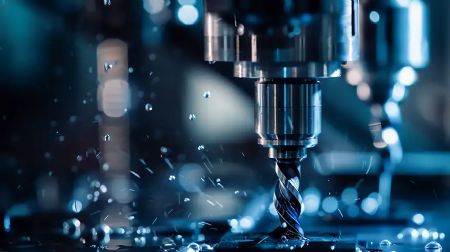
In 2025, the path to embracing CNC automation is anything but simple. While the benefits — such as enhanced accuracy and reduced labour costs — are undeniable, manufacturers must navigate a maze of challenges, from steep capital investments to skills shortages. Hakan Aydogdu, CEO at
Tezmaksan Robot Technologies said: “The CNC machining market is projected to grow from $83,676.1 billion in 2024 to $1,23,627.6 billion by 2032, exhibiting a compound annual growth rate (CAGR) of 5% during the forecast period. With continuous growth expected in sectors like aerospace, automotive and healthcare, the CNC industry is well-positioned to meet the rising demand for high-quality, precision-manufactured components.
“CNC systems are increasingly being integrated with robotic automation that enables faster tool changes and more efficient material handling. This automation enhances production speed, reduces human error and opens the door for more complex designs that would be time-consuming and costly to produce manually. As IoT integration and predictive maintenance also become standard features, CNC systems will become even more reliable, cost-effective and sustainable, helping manufacturers stay competitive in a rapidly changing global market. So, what is the catch? While these trends are transforming CNC automation from a costly investment into a strategic imperative for forward-thinking manufacturers, hesitations remain.”
Mr Aydogdu continued: “One of the foremost barriers to CNC automation remains the high initial cost, especially for small and medium-size manufacturers. The upfront expense not only includes machines but also software, infrastructure and tools for automation. Compounding this challenge is the uncertainty surrounding return on investment (ROI). The long-term benefits of CNC systems, such as increased production capacity and precision, often take time to materialise and depend on successful integration and workforce adaptation.”
Enhancing operational efficiencyHe added: “However, modern advancements are reshaping the cost-benefit equation. The integration of AI, automation and data analytics in CNC systems is not only boosting precision but also enhancing operational efficiency. For example, Tezmaksan’s CubeBOX automation systems increase night shift efficiency by 50%, which can shorten the ROI (return on investment) window to one year. Additionally, Tezmaksan’s rental model also offers an alternative solution for manufacturers hesitant to make large capital investments. With this model, companies can access ‘state of the art’ CNC automation systems on a subscription basis, reducing upfront costs and allowing for greater financial flexibility.”
Another significant challenge is the technical expertise required to operate, program and maintain CNC systems. Many manufacturers struggle to attract and retain a workforce skilled in CNC programming, robotics, CAD, CAM and ongoing system diagnostics. This issue is exacerbated by a growing skills gap, particularly in regions facing labour shortages.

Mr Aydogdu explained: “Technological advances, however, are starting to ease the skills gap. Software solutions like ROBOCAM+, which simplifies CNC programming with its user-friendly interface, makes CNC automation accessible to manufacturers with less technical expertise. Additionally, the increasing role of AI co-pilots in CAM programs allows less experienced workers to handle more complex tasks. By simplifying programming and machine operation, these innovations empower manufacturers to implement automation without needing highly specialised personnel. As a result, this effectively bridges the gap between modern machinery and existing workforce skills.
“CNC automation must be integrated with legacy systems, which can be costly and time-consuming. Compatibility issues often arise when attempting to connect modern CNC machines to older equipment, complicating workflows and requiring significant reconfiguration of production processes.”
Making system integration smootherAs industry moves towards a more digital future, IoT (Internet of Things) integration is making system integration smoother. IoT connectivity enables CNC machines to share data in real time across a connected network, simplifying integration and optimising workflows.
Hybrid manufacturing systems, which combine the precision of CNC machining with the flexibility of additive manufacturing, are also easing the transition by enabling manufacturers to repair, modify or enhance components without overhauling entire systems. This digital transformation minimises downtime and improves overall operational efficiency, reducing the friction that often accompanies system integration.
Concerns over maintenance and downtime are common among manufacturers considering CNC automation. The complexity of modern CNC systems means that malfunctions can result in costly production delays. Predictive maintenance technologies help address this concern by providing real-time data that predicts potential system failures before they occur.
Moreover, IoT-based predictive maintenance allows machines to continuously monitor their own performance, identifying early signs of wear and tear that could lead to breakdowns. This proactive approach not only reduces unplanned downtime but also lowers long-term maintenance costs, making CNC automation less risky and more reliable.
Mr Aydogdu concluded: “Despite the challenges of high initial costs, technical expertise, integration complexities and maintenance concerns, CNC automation remains a critical driver of innovation in manufacturing. By leveraging emerging technologies like AI, IoT and hybrid manufacturing systems, manufacturers can overcome these hurdles and unlock the full potential of CNC automation.
“Manufacturers poised to capitalise on automation trends in 2025 and beyond must adopt a nuanced approach — balancing innovation with strategic planning. By aligning investments with a long-term vision, addressing workforce dynamics and navigating regulatory landscapes, companies can achieve sustainable growth while enhancing their competitive edge.”